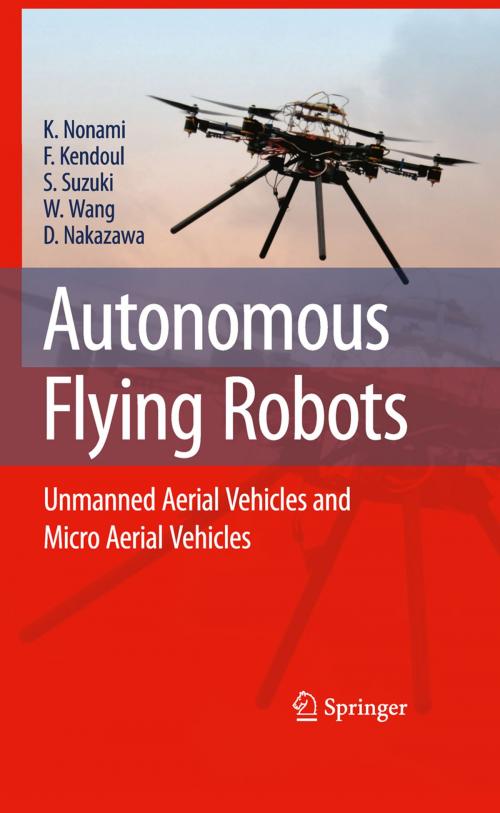Autonomous Flying Robots
Unmanned Aerial Vehicles and Micro Aerial Vehicles
Nonfiction, Science & Nature, Technology, Automation, Computers, Computer Hardware, Input-Output Equipment| Author: | Kenzo Nonami, Farid Kendoul, Satoshi Suzuki, Wei Wang, Daisuke Nakazawa | ISBN: | 9784431538561 |
| Publisher: | Springer Japan | Publication: | September 15, 2010 |
| Imprint: | Springer | Language: | English |
| Author: | Kenzo Nonami, Farid Kendoul, Satoshi Suzuki, Wei Wang, Daisuke Nakazawa |
| ISBN: | 9784431538561 |
| Publisher: | Springer Japan |
| Publication: | September 15, 2010 |
| Imprint: | Springer |
| Language: | English |
The advance in robotics has boosted the application of autonomous vehicles to perform tedious and risky tasks or to be cost-effective substitutes for their - man counterparts. Based on their working environment, a rough classi cation of the autonomous vehicles would include unmanned aerial vehicles (UAVs), - manned ground vehicles (UGVs), autonomous underwater vehicles (AUVs), and autonomous surface vehicles (ASVs). UAVs, UGVs, AUVs, and ASVs are called UVs (unmanned vehicles) nowadays. In recent decades, the development of - manned autonomous vehicles have been of great interest, and different kinds of autonomous vehicles have been studied and developed all over the world. In part- ular, UAVs have many applications in emergency situations; humans often cannot come close to a dangerous natural disaster such as an earthquake, a ood, an active volcano, or a nuclear disaster. Since the development of the rst UAVs, research efforts have been focused on military applications. Recently, however, demand has arisen for UAVs such as aero-robotsand ying robotsthat can be used in emergency situations and in industrial applications. Among the wide variety of UAVs that have been developed, small-scale HUAVs (helicopter-based UAVs) have the ability to take off and land vertically as well as the ability to cruise in ight, but their most importantcapability is hovering. Hoveringat a point enables us to make more eff- tive observations of a target. Furthermore, small-scale HUAVs offer the advantages of low cost and easy operation.
The advance in robotics has boosted the application of autonomous vehicles to perform tedious and risky tasks or to be cost-effective substitutes for their - man counterparts. Based on their working environment, a rough classi cation of the autonomous vehicles would include unmanned aerial vehicles (UAVs), - manned ground vehicles (UGVs), autonomous underwater vehicles (AUVs), and autonomous surface vehicles (ASVs). UAVs, UGVs, AUVs, and ASVs are called UVs (unmanned vehicles) nowadays. In recent decades, the development of - manned autonomous vehicles have been of great interest, and different kinds of autonomous vehicles have been studied and developed all over the world. In part- ular, UAVs have many applications in emergency situations; humans often cannot come close to a dangerous natural disaster such as an earthquake, a ood, an active volcano, or a nuclear disaster. Since the development of the rst UAVs, research efforts have been focused on military applications. Recently, however, demand has arisen for UAVs such as aero-robotsand ying robotsthat can be used in emergency situations and in industrial applications. Among the wide variety of UAVs that have been developed, small-scale HUAVs (helicopter-based UAVs) have the ability to take off and land vertically as well as the ability to cruise in ight, but their most importantcapability is hovering. Hoveringat a point enables us to make more eff- tive observations of a target. Furthermore, small-scale HUAVs offer the advantages of low cost and easy operation.















